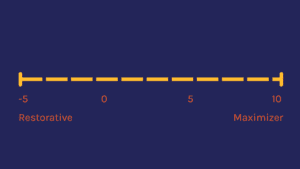Welcome to Friday 411, issue #085. In 4 minutes, with 1 insight and 1 action, you’ll gain results by bringing two conflicting sides of your team together.
1 Insight
In teams, different perspectives can cause conflict. One common set of opposing viewpoints creates particularly difficult challenges.
Our friend, Mark, stared at us, his brow cinched in confusion.
While talking with a group of friends, Mark had mentioned how annoying it is when you’re eating at a restaurant with someone, and they say, “This is good. But you know what would make it better?”
After the two of us exchanged glances, Garland had been the one bold enough to fess up.
“Um. Dorothy and I do that all that time.”
This is the statement that had led to Mark’s brow-cinching befuddlement.
“What do you mean you do that all the time? Why?”
Dorothy tried to explain. “It’s fun. We love tasting something really good and imagining what could be added to make it even better.”
Mark continued to stare at us. “Help me understand this. Let’s say Dorothy cooks something for you, Garland. After her hard work, she sits it down in front of you. You taste it. And start talking about what would make it better? How are you not kicked out of the kitchen at this point?”
Dorothy laughed. “If he starts talking about what would make it better, that’s how I know he thinks it’s good. If he didn’t like it, it wouldn’t inspire a conversation. We both get excited about tweaking recipes into the realm of excellence. We love doing stuff like that together.”
Mark looked at us, flabbergasted. He did not get us.
But we got him. We got him because we have led similar conversations with many teams over the years.
Your Strengths Alter Your Perception of the World
Our favorite assessment for both individual growth and teaming is CliftonStrengths. CliftonStrengths organizes talents into 34 categories, called themes. Your themes not only help define and clarify your personality traits, but also all the other ingredients in our recipe for self-knowledge. The seven ingredients are:
1. Personality
2. Strengths
3. Weaknesses
4. Passions
5. Values
6. Preferences
7. Triggers
Everyone views and translates the world around them through their own unique lenses. Identifying themes opens a window into these distinct perspectives so that you can understand yourself and others better.
Over the years of working with teams, we have found that two of the themes that cause the most conflict are restorative and maximizer.
When placed on a spectrum, restorative refers to the gift people have of fixing what is broken or problem-solving. These individuals are able to bring situations, projects, or traits up from the negatives to zero or a bit beyond.
On the other end of the spectrum, maximizer is the talent of raising what is functioning into the excellent range. People with these talents can elevate what has been fixed, what is working, or what may be hanging out at mid-range up to a nine or ten.

A Tale of Two Clients
Beth and Theo worked in sales for an event planning company. During their weekly staff meeting, each shared about a client they had been focusing on.
First, Beth:
“I have a lot of hope for our future with Great Leaf. I know they lost confidence in us last year when we promised eight of our staff would be present for their event, and we only brought six. When they threatened to end our contract over that, it really lit a fire in me. I have been touching base with their CEO at least once a week, trying to mend the relationship. I’m going to pay him a visit this week and see how we can fix this.”
Then, Theo:
“I really don’t get why you’re wasting so much time with Great Leaf, Beth. Seems like a lost cause to me. I believe our future is with Twelve Roads. We did four events with them last year. I’ve been building that relationship. I think we could double that number for next year!”
Though they may not see it, neither focus is wrong. They are each approaching business development from their own set of natural talents, thus a different viewpoint.
How Maximizers and Restoratives Can Get Caught in Conflict

Restoratives and Maximizers Need Each Other
The best teams are the most well-rounded with the most themes represented. We have found the strongest teams have both restoratives and maximizers. Restoratives steward the kick-off, getting the game going in a healthy direction. Then maximizers pick up the ball and run with it, taking it in for a touchdown.
But before this beautiful symmetry can be achieved, effort is required to open up perspective and create understanding. What can restoratives and maximizers do to work better together?
- Talk openly about each individual’s way of approaching the world. On the restorative/maximizer spectrum, where does everyone on your team land? How well does each person understand the other end of the spectrum?
- Study the restorative/maximizer potential conflict chart above. Which description(s) has your team experienced? How can you understand one another’s viewpoints better?
- Talk about the value each end of the spectrum brings to the team. What would be the result of a team with no restoratives? With no maximizers?
- Learn to leverage the strengths of each other. If you’re a maximizer who encounters a problem, ask for help from the restoratives. If you’re a restorative who realizes you need to take things to the next level, lean on the maximizers. How will depending on one another’s natural wiring gain better results for your team?
One more lesson: if you’re a maximizer, don’t suggest to your restorative friends how to make recipes better. But you’re welcome to do that to us anytime we eat together. Unlike our friend, Mark, we totally get you.
1 Action
Identify the restoratives and maximizers on your team and facilitate a conversation using the four discussion points provided.


